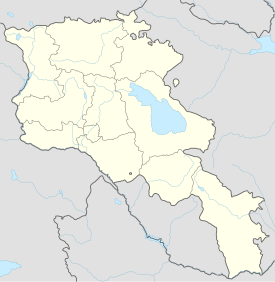Sardari Berd
| Sardari Berd Սարդարի Բերդ |
|
|---|---|
| Armavir Province, Armenia | |
| Coordinates | 40°08′10″N 44°00′50″E / 40.1361°N 44.0139°E |
| Type | Fortress |
| Site information | |
| Controlled by | Before its capture, the Persian Qajar governors of the Erivan Khanate. |
| Open to the public |
Yes |
| Condition | Very little of the fortress survives; Stones were used to build Soviet Armenia. |
| Site history | |
| Built | Between 1807-1828 |
| Built by | Sardar Hosein Qoli Khan |
| In use | As a fortification, as administrative center for the Sardarapat district and as a summer residence of the Khan of Yerevan. |
| Materials | Stone; Some stones used from the ancient city of Armavir. |
| Demolished | Yes |
| Battles/wars | Captured by the Russians under General Ivan Paskevich in 1828. |
Sardari Berd (Armenian: Սարդարի Բերդ: deriven from Sardar Persian: سردار; a title of Persian origin, used for military or political leaders meaning "commander" or "chieftain" and Berd Armenian: Բերդ; meaning "fortress".) sits on the right before the cemetery in the village of Hoktember in the Armavir Province of Armenia. It is actually historically associated with the city of Armavir which was then known prior to 1932 as Sardarabad or Sardarapat.
The fortress was built sometime between the years of 1807 and 1828, during the rule and with the assistance of Sardar Hosein Qoli Khan Qajar (Sardari Iravani), the last and best of the Persian Qajar governors of the Yerevan Khanate. It was constructed using stones taken from the ruins of the ancient city of Armavir, some of which still bear traces of Urartian cuneiform inscriptions. The fortress was used as an administrative center for the Sardarapat district and also as the summer residence of the Khan of Yerevan (Erevan).
Sardari Berd was captured in 1828 by the Russians under General Ivan Paskevich during the Russo-Persian War (1826-1828), despite strong defense by Hasan Khan Sardari Iravani, brother to Sardar Hosein Qoli Khan. Speaking of Paskevich in a British War Office summary, the following passage reads:
...
Wikipedia

